When you need electricity for an emergency or camping, portable power stations are clean, quiet source of power. They can easily power a long list of devices but they also need to be charged. Luckily they can charge from an AC outlet or car charger but what if you’re off grid or aren’t running the truck all the time?
Portable power stations can also be charged by solar panels. When the sun is out, they generate ‘free’ power to charge up those power stations. The power stations then run fridges, cameras and computers when you’re out camping, living in the van or trying to deal with some sort of emergency power outage.
The EcoFlow 110W Solar Panel
EcoFlow make portable power stations and solar panels. EcoFlow was born in the 2017 when a group of drone battery experts decided to take all their knowledge of lightweight and long-lasting batteries to build large portable power stations. They started in 2017 with the portable River series of batteries and added the larger Delta series soon after.
To power those all those portable power stations, they also sell 2 sizes of lightweight solar panels: the 110 watt solar panel and the 160 watt.
Both solar panels come with a nice carry case and unfold into 4 sections. The 4 panels of the 110 watt version can generate 27.5 watts each, while each of the 4 panels on the 160W can generate up to 40 watts.
In this review of the 110W Solar Panel from EcoFlow we’ll have a look at how well it charges, what connections it has, and how to stand it up with the case.

Specs
First a quick look at the specs.
- 110 watts
- 4 folding panels
- MC4 connections
- Waterproof
- 13 pounds (9 pounds for the panels)
- 32 mono-crystalline cells
- 22% efficiency
- 62.5 x 20.2 x 1.0 inches unfolded
Next up, what connections does the 110W have? Does it have connectors for everything or keep it simple with one?
Setting up the case
The EcoFlow 100W solar panel comes with a nice carry case. Right out of the box it looks and feels high quality and is comfortable to hold. Two handle straps are kept together with a nice velcro wrap. The velcro strap is soft and comfortable to hold.
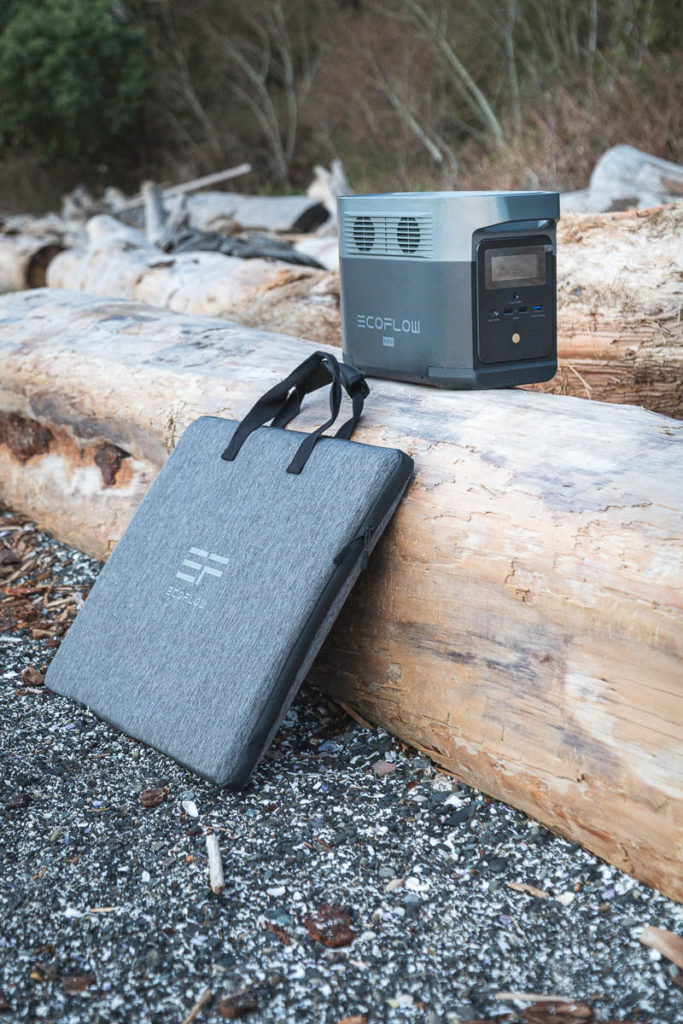
One side of the case is made out of a stiff material and a water resistant zipper unzips around three sides of the case. I found putting the soft side of the case on the ground and unzipping the case all the way around was the easiest way to open things up.
Once the case is open, you can use the stiff side of the case as a kickstand to hold the whole panel up. Inside the top and bottom of the case are small carabiners that clip to the top and bottom of the panel. Just clipping the top holds the panel up most of the time. If it’s windy, clipping the bottom helped to hold everything up better.
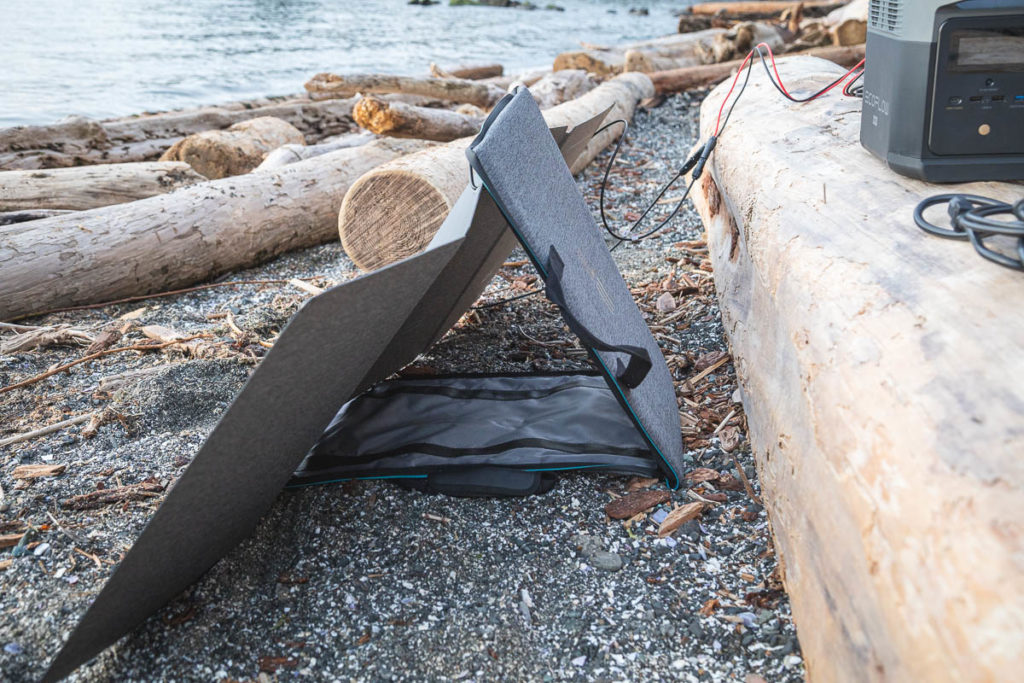
Having just the top of the panel clipped to the case, I was able to move adjust the angle easily to the sun. Solar panels work best when they are perfectly 90 degrees to the sun so to get the most juice, you have to adjust them as the sun moves a bit. It’s early spring here when I’m testing this so the sun is a bit lower. It’s easy to move the panel where it needs to be.
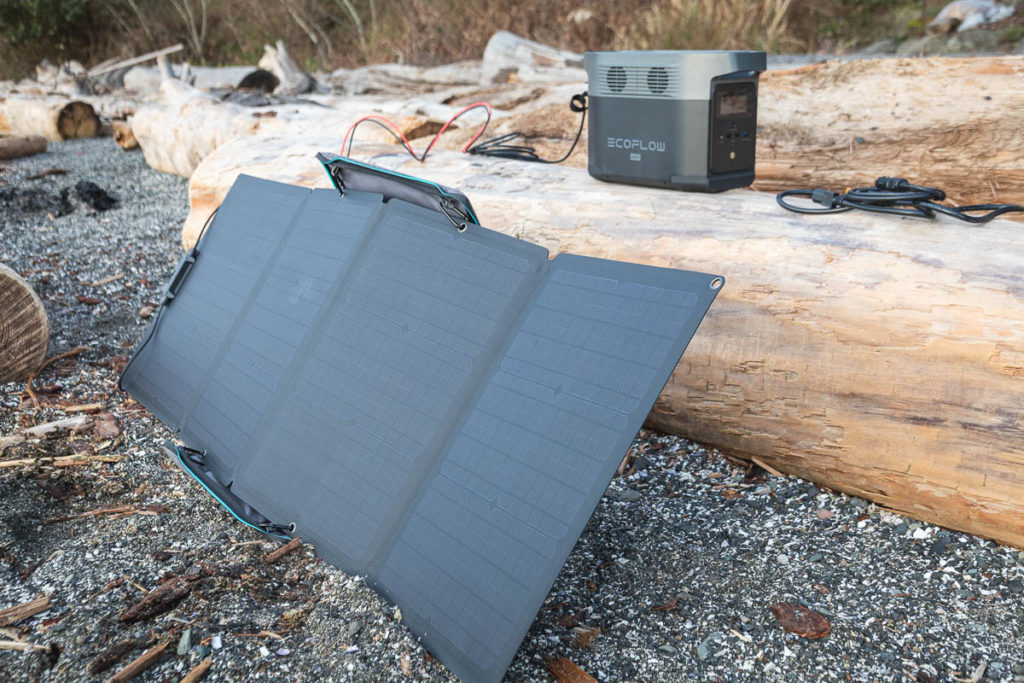
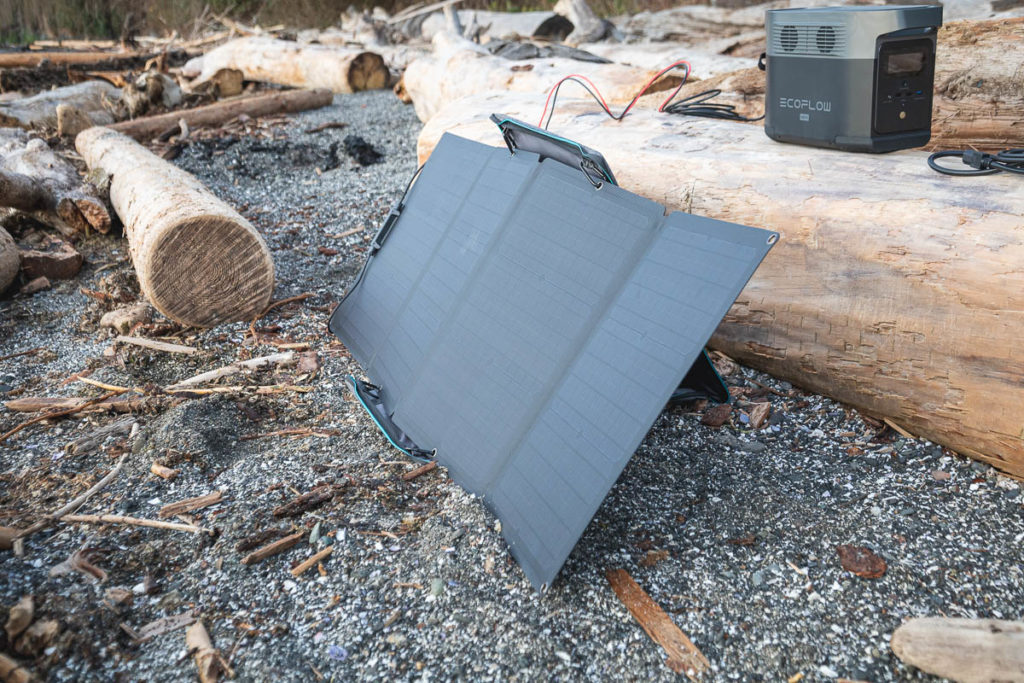
Of course, just leaning the panel against the truck or some chairs works too. It’s nice to have the option to set up with the case but it does take a little longer than panels that just fold open with an attached kickstand. If you are constantly setting them up and taking it down, it will take a little longer.
One other benefit to the case I really like is storing all the cables inside it. There’s a bit of extra room and the 3 charging cables that come with the EcoFlow Delta Mini for charging easily fit inside. Otherwise, they have to go in some other bag.
Connections
The 110W panel keeps it simple and has 1 connection type. It uses the industry-standard MC4 connection built right into the panel. Out of a small lump on the right end of the panel (doesn’t matter which side of the panel is up) come the 2 MC4 cords, one positive and one negative.

The MC4 connection can basically adapt to anything. It can easily be connect to XT60, DC, Anderson or other connectors with cheap adapters from Amazon. It can connect to a EcoFlow Delta Mini, Jackery 1000 or GoalZero Yeti 1000X. MC4 has two connectors and can’t go backwards, the connectors are male and female and can only go one way into other devices.

If you want to charge up devices faster like a larger power bank, you can chain up to four solar panels together. This requires branch connectors to put two MC4 connections into 1 but they are easy to find.
One thing that could be improved on the 110W is where the cables connect to the panel. They come out of the front of the panel. I’d prefer they come out of the back so they don’t hang in front of panels blocking the sun. They’re thin and small but the cables would be tidier coming out the back. I usually store the battery and the rest of the cords behind the panel anyways.
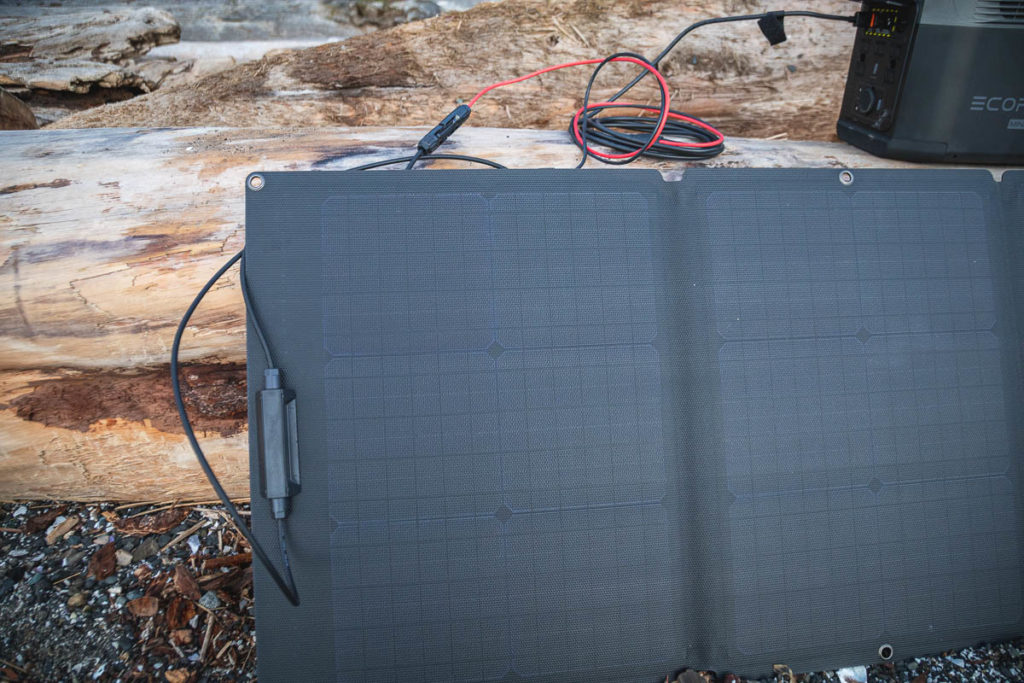
Charging
The all important charging. Clearly, if a solar panel doesn’t charge well, there’s not much point.
EcoFlow’s 110W solar panel charges well.
With light spring sunshine I easily got 70 to 80 watts charging. I’m sure it will be even higher with strong summer sun. No solar panel gets 100% efficiency so even getting close to your max charging wattage is great.
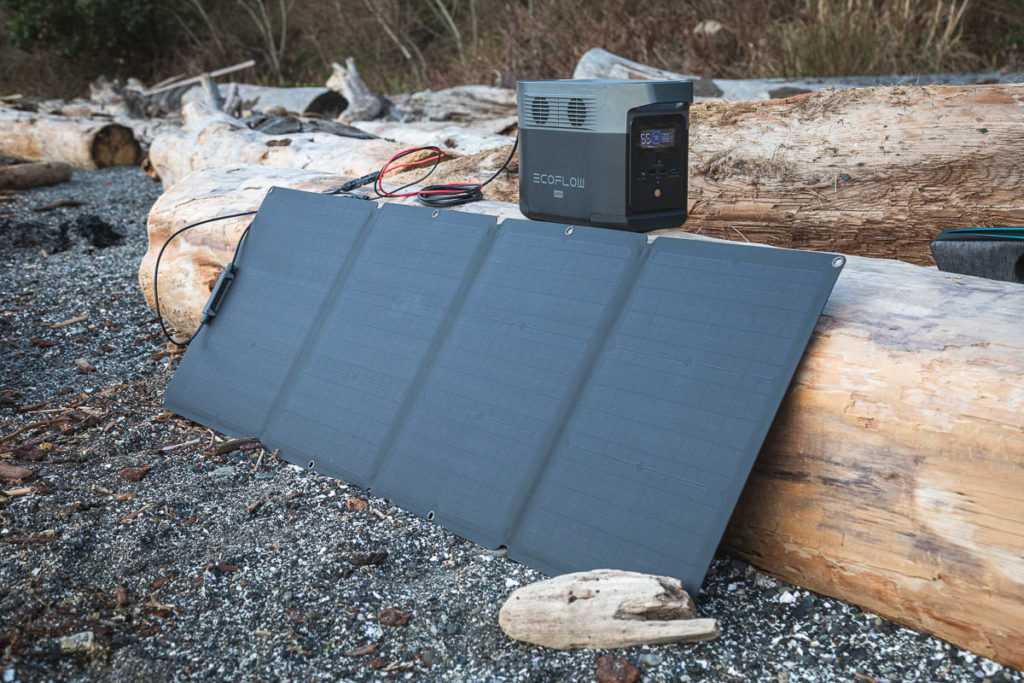
32 monocrystalline cells with 22% efficiency on the 110W panel seem to work well.
Running only 1 panel will get you 70 to 80 watts so that’s going to charge the EcoFlow batteries in a certain time:
- River 3-6 hours
- River Max 6-12 hours
- River Pro 9-18 hours
- Delta 14-28 hours
- Delta Mini 10-20 hours
If you want, you can chain up to 4 of them together and charge the larger battery packs faster. Each of the battery packs have a max solar input wattage so something like the Delta Mini can only take 300 watts from the solar input at a time.
I was testing with the MC4 to XT60 cable into the Delta Mini battery. The MC4 connections only go 1 way into the connector cables.
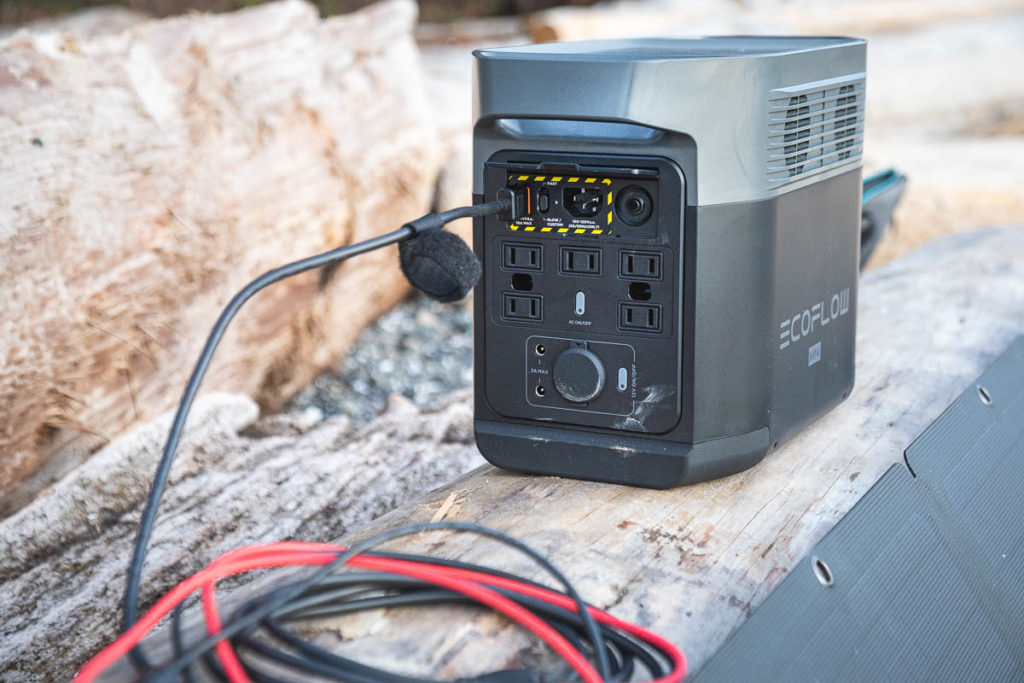
160 watt version
EcoFlow also have a 160 watt version of the solar panel. It’s the same with build and materials but just slightly taller with a few more solar cells. Instead of 20.2 inches tall like the 110 watt version, the 160 watt version is 26.8 inches tall.
Because of the additional cells in the larger panels it can generate up to 160 watts instead of 110 like the smaller panel. The panels will never get the output from the name or specs since that’s from perfect conditions but the good panels can get close.
Conclusion
Verdict: Recommended
Rating: 8/10
Overall the quality and performance of the EcoFlow 110W solar panel is very good. It can easily get 70 or 80 watts in light sunshine.
The case does take a minute to set up but it helps to stand the up the panel as well as protect the panels when you’re moving around. Other panels that don’t come with cases can get damaged if you’re moving around a lot.
you posted 110watt panel charge times for the following ecoflow models :
River 3-6 hours
River Max 6-12 hours
River Pro 9-18 hours
Delta 14-28 hours
How long is the charge time for Delta mini (fast charge) with the 110watt panel ?
Hey Henry,
Ecoflow says 10-20 hours. I’ll try to test mine in the sun/cloud we’re getting this week and see what I get.
Great article! The EcoFlow 110W solar panel is designed to work in conjunction with charging power stations to provide a clean and sustainable source of energy. It can be used to recharge portable power stations, such as the EcoFlow Delta or River series, which can then power a variety of devices like phones, laptops, and camping equipment. The 110W solar panel can be set up easily and quickly, and is made from durable materials to withstand outdoor conditions. The amount of power generated by the panel depends on the amount of sunlight it receives and the orientation of the panel towards the sun. Overall, the EcoFlow 110W solar panel can be a great addition to a portable power system, providing reliable and renewable energy on the go.